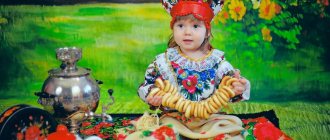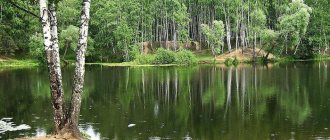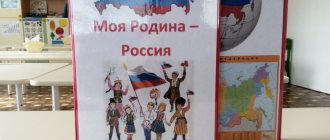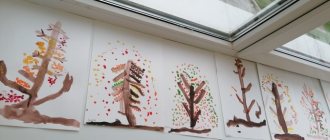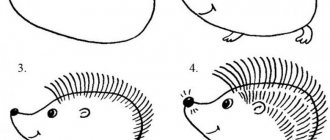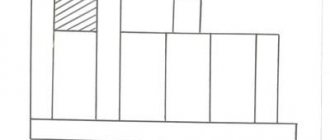Conversation with children of the middle group “Russia is my Motherland!”
Conversation with children of the middle group “Russia is my Motherland!”
Target:
instilling in children of this age a sense of patriotism and respect for their homeland.
Tasks
: to form an idea in children with such concepts as “Russia”, “Motherland”, “Fatherland”; introduce the primary ideas of symbolism and the Russian Anthem.
Recommendations
.
The conversation is of an overview nature. In a form accessible and understandable to children, the teacher introduces them to such concepts as “Motherland, Russia.” These two words are inextricably linked. We all live in the largest country in the world - Russia. Russia is our big Motherland. But every person also has a small homeland. This is the place where he was born (city, village, village) and lives (house, family).
Progress of the conversation
Questions
- What is the name of the city where you live?
- Tell us about your home and your family.
Educator
.
There are a lot of big and small cities, villages and villages in our country. They are all beautiful in their own way. But the largest city is Moscow. Moscow is the capital of our Motherland. (The teacher shows illustrations with views of Moscow.)
People of various nationalities live in Russia (Kazakhs, Kalmyks, Tatars, Chuvash, Tajiks, Bashkirs, Udmurts and many, many others), but the majority of Russians are Russians.
Questions:
- Remember which Russian cities you know, list them.
- What are people whose homeland is Russia called? (Russians.)
Russia is also our Fatherland - the place where our ancestors and grandfathers lived, where our fathers live, where we live. Every person should love and respect their Motherland. She raised and educated many great and world-famous people. (The teacher shows portraits of famous figures of science and art who left their mark on the history of our state.)
We should be proud that our compatriots were Lomonosov, a scientist whose discoveries and works brought many benefits to all of humanity; Tchaikovsky is a great Russian composer whose name is known throughout the world. The first person to conquer space was Russian - Yuri Alekseevich Gagarin. These and many, many other people glorified our Fatherland with their deeds and exploits.
Each country in the world has its own symbols, that is, insignia - its own flag, coat of arms and anthem.
The Russian flag is tricolor, that is, white-blue-red. Each color has its own meaning. The color blue signifies loyalty, intelligence and honesty. Red – courage, love and beauty. White – purity and clarity, peacefulness.
The coat of arms of Russia is a double-headed eagle - a symbol of wisdom and fearlessness, intelligence and generosity. He vigilantly looks around, protecting Russia from the enemy.
Hymn
- the most important song in Russia.
The anthem is performed on especially solemn occasions. The anthem is performed and listened to while standing. (Children listen to a recording of the Russian anthem, talk about its content, the teacher introduces the authors of the anthem.)
Listening to the National Anthem of the Russian Federation
The words to the Russian anthem were written by the famous writer and poet Sergei Mikhalkov. His works are known and loved by children because he dedicated almost all of his work to children.
The music for the anthem was written by the famous composer A. Alexandrov.
Many wonderful songs and poems are dedicated to Russia. They glorify our Motherland, its forests and fields, rivers, and talk about love and pride for our country, small and large Motherland. The Russian people have many proverbs and sayings about this.
Proverbs and sayings
- A person has one natural mother - he has one Motherland.
- The Motherland is your mother, know how to stand up for her.
- Heroic Rus'.
- Where someone was born, that’s where they came in handy.
- The native side is the mother, the alien side is the stepmother.
Questions:
- Name the country in which you live. (Russia.)
- What is the name of the city (village) where you live?
- Which Russian river is called the great? (Volga.)
- What Russian cities do you know?
- What is the name of the city that is the capital of our Motherland? (Moscow.)
Summary of the lesson.
MAGAZINE Preschooler.RF
Summary of educational activities in the middle group, taking into account the regional component. Topic: “My Motherland – Cherepovets”Integration of educational areas: “Cognitive development” , “Speech development” , “Socio-communicative development” , “Reading fiction” .
Goal: To consolidate children’s knowledge about their hometown, as about their small homeland.
Software tasks:
Educational: Clarification and consolidation of general ideas about your “small homeland” , hometown. Fixing the names of rivers, streets, avenues, squares, and transport in the city of Cherepovets. Expansion and activation of the dictionary on the topic: “Our city” (due to nouns: city, coat of arms, flag, Cherepovets, river, Sheksna, Yagorba, street, avenue, square, transport).
Developmental: Develop coherent speech through complete answers to questions.
Develop imaginative thinking and memory. Develop attention, imagination, creativity, creating a positive emotional mood in preschoolers.
Educational: Formation of skills of cooperation, mutual understanding, goodwill, patriotism. Cultivate love and a sense of attachment to your hometown. Foster a sense of pride in your hometown.
Methods and techniques:
Visual: showing, viewing, watching.
Verbal: explanation, questions, examination, conversation, comparison, artistic expression.
Practical: D/i “Collect a picture” (Coat of arms of the city of Cherepovets), Low mobility game: “Make the flag of Russia” , slide show “My homeland is Cherepovets” .
Individual work: memorizing poems, text for a character.
Preliminary work: Conversations, reading stories, memorizing poems about the homeland, about the hometown. Examination of illustrations of the Russian flag, the coat of arms of the city of Cherepovets. View photo albums “Cherepovets in different seasons” , “Rivers of Cherepovets” . Looking at photographs of our city’s streets, squares, various buildings, and transport. Collecting photographs and creating a slide show on the topic: “My homeland is Cherepovets .
EQUIPMENT: Costume for the character, audio recordings, video recording of a slide show, cut-out picture of the coat of arms of Cherepovets, colored ribbons (white, blue, red), laptop, music speaker.
Progress of educational activities:
Organizing time. Creating an emotionally positive background.
Children sit on chairs. The sound of a propeller is heard, and Carlson (a child dressed as Carlson) flies into the hall to the music.
Carlson: Do you guys recognize me? I am traveling around your big country of Russia and arrived in your city, but I don’t know anything about it, no streets, no buildings, no addresses, I don’t know which roof to fly to.
Educator: Guys, let's help Carlson find out everything about our city, about our Motherland. (Children's answers)
Carlson: Motherland! And what is it?
Educator: The guys will now tell you the poem: “What we call Motherland” by V. Stepanov and you will understand everything.
1. “What do we call Motherland? The house in which we live and the birch trees along which we walk next to our mother.”
2. “What do we call Motherland? A field with a thin spikelet Our holidays and songs Warm evening outside the window.”
Educator: Homeland is the place where a person was born into a family and lives in his city.
Carlson: And what is the name of your city? (children's answers)
Educator: Our hometown is called Cherepovets. Carlson, listen to these beautiful poems, the children know about our city.
1. Our city has stood on Sheksna for many, many years. He is majestic, proud, from his victories.
2. We love our city, our hometown. It is beautiful in summer, beautiful in winter. He dressed himself in parks, bridges and palaces, which were built by his grandfathers and fathers.
Educator:
— Our city of Cherepovets stands on two rivers: Which children? (Children's answers). That's right, Sheksna and Yagorbe.
— Guys, what streets are there in our city? (children's answers) There are many streets in our city, children tell Carlson which streets you know. (Children's answers) Yes, Lenin Street, Embankment, Leningradskaya, Godovikova and there are many other streets. What prospectuses do you know? (Children's answers) Sovetsky Ave., Sheksninsky Prospekt, Pobeda Ave., etc.
What areas do we know? (Children's answers) Milyutin Square, Metallurgists Square, Chemists Square.
This is how much we know about our city. Now Carlson, we will play a game, and you will try to guess what picture we collected. Game "Collect the picture" . (Coat of arms of the city of Cherepovets)
Carlson's answer. Educator: This is what the coat of arms of our hometown of Cherepovets looks like. And try to collect our coat of arms. Carlson collects a coat of arms.
Educator: And now Carlson, sit down with the guys, and let’s all watch our film together, which we called “My Motherland-Cherepovets”
(View SLIDESHOW)
Educator: This is how our film turned out. Now let's play a little more. Get yourself some ribbons. The game is called “Collect the Russian flag” .
Low mobility game. Look what we got? FLAG OF RUSSIA.
At the end of the game, the teacher reads V. Stepanov’s poem “Flag of Russia”
White is the color of birch, Blue is the color of the sky. Red stripe - Sunrise.
Reflection:
Well, Carlson, have you learned a lot about our city? Carlson: Yes, I really liked it with you, I will come to you more often! Goodbye! Flies away.
Educator: He flew away, but promised to return.
| Next > |
